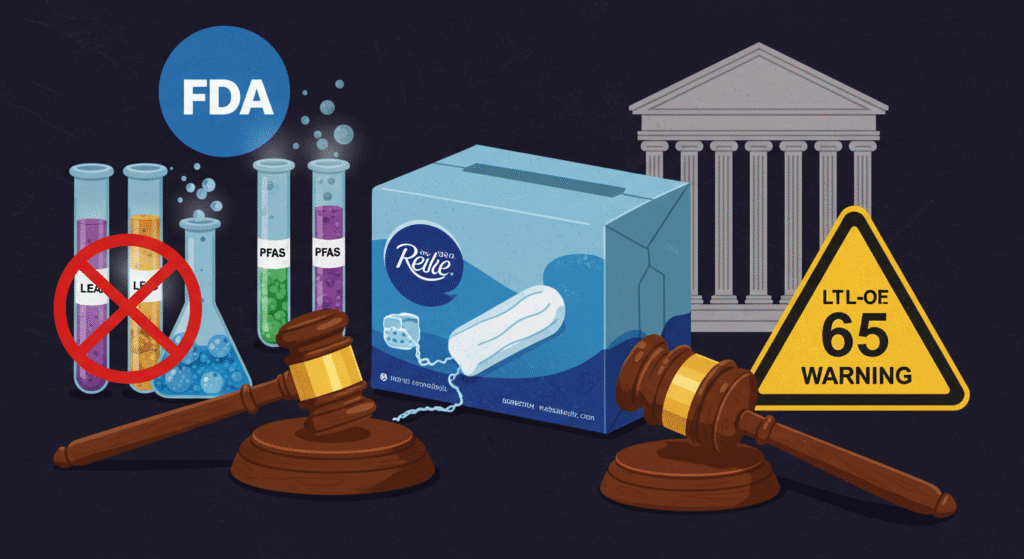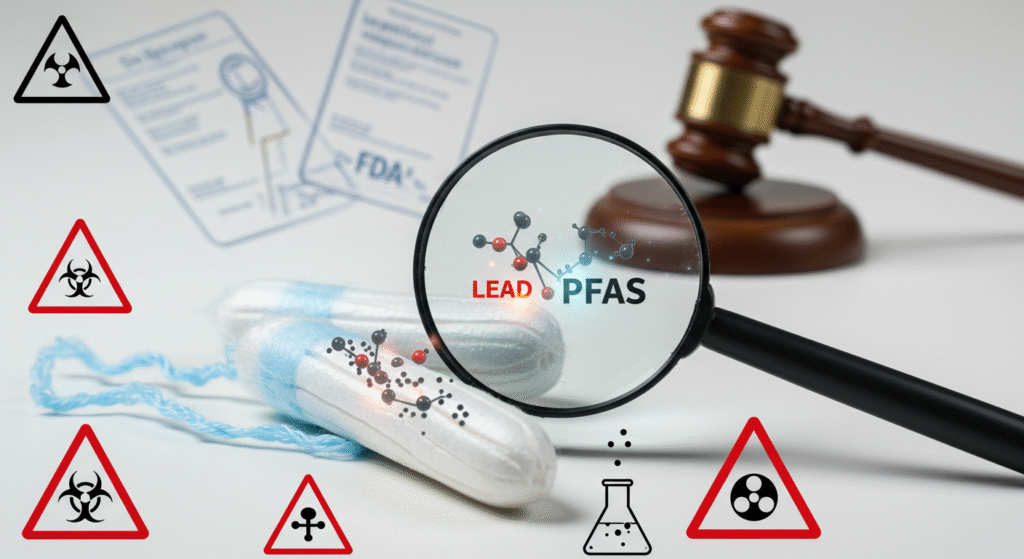Introduction
Tampons help many women during their periods. They seem safe and easy to use. But in 2025, people found problems with Tampax tampons. They say Tampax has bad chemicals called lead and PFAS. These can hurt your body. People are now suing Procter & Gamble, the company that makes Tampax.
I’m Orland Howell, and I’ve written about lawsuits for years, so I know this news can scare you. Women trust tampons to be safe. This article explains everything in very easy words. It talks about the claims, tests, and what you should do. I’ll keep it super simple.
The lawsuits say Tampax hid these chemicals. Courts are looking at this in 2025. One case is going forward. Another was stopped. Lead can make you sick. PFAS stay in your body and cause big problems.
If you use Tampax, keep reading. You need to know what’s happening and how to stay safe. This is for you.
What Are Lead and PFAS? Why Should You Care?
Let’s talk about these chemicals. I’ll make it easy to understand.
Lead is a bad metal. It’s in old paint or pipes. It’s not safe in your body at all. When lead gets in you, it stays and builds up. In tampons, lead can go into your blood through the skin down there. That skin takes in things fast. Lead can hurt you. It can mess up your brain. It can make kids learn slower. For women, it may cause high blood pressure or kidney problems. If you’re pregnant, it could harm your baby. That’s scary.
PFAS are different. They’re called “forever chemicals” because they never go away. They stay in your body and the world for years. Companies use PFAS to make things not stick or not get wet. But they don’t belong in tampons. PFAS can cause bad things. They’re linked to cancer, like kidney or testicular cancer. They can hurt your thyroid, which gives you energy. They can mess with periods or make it harder to have babies. Almost everyone has PFAS in their blood, but tampons make it worse.
Tampons touch soft skin that soaks up chemicals fast. Even a little bit of lead or PFAS is bad. Tests in 2024 and 2025 found these chemicals in many tampons, not just Tampax. But Tampax is in the news a lot.
How Tests Found the Problem
How did we learn about this? Scientists did tests. In 2024, people at UC Berkeley tested 30 tampons from 14 brands. They looked for 16 metals. Every tampon had some bad ones, like lead, arsenic, and cadmium.
For Tampax, tests showed lead from 0.243 micrograms in light tampons to 0.787 micrograms in heavy ones. That’s for one tampon. Women use 3 to 6 tampons a day during periods. That adds up fast. California says 0.5 micrograms of lead a day is the safe limit. On a heavy period day, you go way over that.
PFAS tests started earlier. In 2022, a group called Mamavation tested tampons and pads. They found PFAS in many. For Tampax Pure Cotton, a 2023 test found 23 parts per million of a chemical that shows PFAS. The lab said, “Don’t use these.”
Why are these chemicals there? Cotton grows in dirt. Dirt can have metals from old factories or bad water. PFAS come from making tampons soft or packages strong. Even “organic” tampons had them, which surprised people.
In 2025, the FDA started testing tampons for metals to see if they’re dangerous. Right now, no rules make companies test tampons. Tampons are called “medical devices,” but the rules are not tough.
These tests are important. They prove the lawsuits have real reasons.
The Lead Lawsuits: What People Say
The big problem is lead in Tampax. Lawsuits started in 2024 and got bigger in 2025.
In July 2024, a woman named Allison Barton sued in California. She said Tampax Pearl tampons have too much lead. Procter & Gamble didn’t tell people. She did her own tests and found high lead levels.
Barton wants money back for everyone in California who bought these tampons. She says the labels lie by saying “safe” and “gentle” when lead is inside. The lawsuit says the company did wrong by not being honest. Procter & Gamble tried to stop the case. They said it’s not strong. But in August 2025, Judge Gonzalo Curiel said the case can go on. He only stopped a small part of it.
In September 2025, a judge planned talks for October 31. They’ll try to settle. Procter & Gamble must send people who can agree to a deal. More lawsuits came. In November 2024, Einaya Morciglio sued in New York. She said the same thing: lead was hidden, and Tampax broke safety promises. In August 2025, Stephanie Foster sued in California too.
In February 2025, a judge stopped some claims about fraud against Procter & Gamble. But the main lawsuits are still going. People are upset. They say, “I trusted Tampax, but now I’m scared for my health.” Many used Tampax for years. Some feel tired or have period problems, but there’s no proof it’s from tampons yet. The worry is real.
These lawsuits are for many people. If you bought Tampax in California or New York, you can join. You don’t need to show you got sick—just that you bought tampons thinking they were safe.
The PFAS Lawsuits: Chemicals in “Pure” Tampons
PFAS lawsuits are about Tampax Pure Cotton tampons. They’re different from lead cases but similar.
In 2023, three women sued Procter & Gamble. They said the “100% organic cotton” label was a lie because tests found PFAS. Brittany Bounthon and others paid more for “natural” tampons but got chemicals. Procter & Gamble said the tests only found fluorine, not real PFAS. In July 2025, a judge agreed and stopped the case. The women tried to fix their claims but couldn’t.
People are still worried. In 2025, some company owners asked Procter & Gamble for a PFAS report. There’s no answer yet. Other lawsuits about dyes or other chemicals in tampons are happening too.
These PFAS lawsuits show people don’t trust the “natural” label anymore. They want safe tampons, but tests found problems.
What the Company and Rules Say

Procter & Gamble says the lawsuits are wrong. They say their tampons are safe and follow rules. They haven’t pulled any tampons from stores. But they’re feeling pressure.
The FDA is looking into it. In 2025, they started testing tampons for metals to see if they hurt people. They might make new testing rules soon. Some groups want PFAS banned from all hygiene products. States are acting too. California has a rule called Proposition 65 that says products with lead need warnings. Other states might do the same.
Procter & Gamble had trouble before. In 1980, their Rely tampons caused toxic shock syndrome, and some women died. They stopped selling them. Now, people are watching them closely.
What This Means for You
If you use Tampax, this news matters. Here’s what to do.
First, check your health. Do you feel tired all the time or have weird period changes? See a doctor. Ask for tests to check for lead or PFAS in your blood. Finding problems early helps.
Second, think about your money. If you bought Tampax Pearl or Pure Cotton in the last four years, you might join a lawsuit. The Barton case in California could give you money back if it settles. You just need to show you bought the tampons. How do you join? Look at websites like Top Class Actions. They list lawsuits you can join. You can also call a lawyer for free help.
Third, try safer products. Brands like Natracare or Seventh Generation say they have no metals. Check labels to be sure. You can also use pads or menstrual cups like the Diva Cup, which are often PFAS-free.
Finally, speak up. Tell your friends about this. Sign petitions to ask the FDA for better rules. Your voice can make a difference.
I’ve written about lawsuits for four years. One thing is clear: companies must tell the truth. You deserve safe tampons.
Tips to Stay Safe
Here are easy ways to protect yourself:
- Pick brands that test for PFAS and metals. Look for “PFAS-free” or “metal-free” on the box.
- Use fewer tampons. Try pads or period underwear on light days.
- Wash your hands after touching tampons, but the main worry is using them inside.
- See a doctor every year. Ask for blood tests for toxins.
- Keep up with news. Check FDA updates in 2025.
There’s no perfect answer yet, but these steps keep you safer.
What’s Next for Tampons
These lawsuits might change how tampons are made. All brands may need to test more. Labels might have to show warnings. Bad chemicals could be banned.
For women, trust is hard to get back. But this pushes companies to make better tampons.
In 2025, watch the October talks. Will there be a deal? Will new rules come? Stay ready.
Conclusion
The Tampax lawsuits show a big problem. Lead and PFAS in tampons hurt trust and health. Tests prove the claims, and lead lawsuits are moving forward. PFAS cases had a problem, but people are still fighting. I’m Orland Howell, and I’ve covered many lawsuits. This one is personal because it’s about your body and trust. If you’re worried about your health, see a doctor. If you want safer options, switch products. You have rights—use them.
Disclaimer: This article is for information only. It is not legal or medical advice. Always talk to a lawyer or doctor for advice about your specific situation. The facts in this article come from public sources available as of September 26, 2025. We have done our best to make sure the information is accurate, but things can change. Check with professionals for the latest details.
Explore More:
Branson Nantucket Lawsuit — January 27, 2025 Appeal Upheld: What Timeshare Owners Need to Know
Quaker Oats Lawsuit 2025 — $6.75 Million Deal, Recalled Products, and How to Get Your Money

Orland Howell is a seasoned content writer with four years of deep expertise in crafting compelling and informative content about lawsuit settlements. With a keen understanding of legal nuances and a talent for translating complex topics into clear, engaging narratives, Orland helps law firms, legal professionals, and clients communicate effectively. His work spans blog posts, articles, whitepapers, and website content, all designed to educate, inform, and drive results. Passionate about empowering audiences with knowledge, Orland combines precision, creativity, and industry insight to deliver content that resonates and builds trust.






